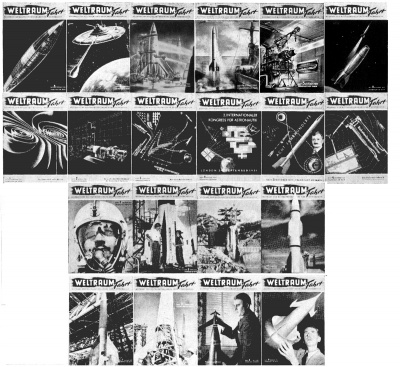Weltraum Fahrt Beiträge Zur Weltraumforschung Und Astronautik
From The Space Library
Covers of the years 1950-1952 of the German journal "Weltraum Fahrt"
Journal of the Gesellschaft für Weltraumforschung based in Stuttgart Germany. The journal began in January 1950 and was originally edited by Heinz Gartmann. In 1950 and 1951 it was published six times a year. From 1952 to 1960 it was published quarterly. From 1961-62 it was back to six times a year.
Cover art for the first issue (top left above) was created by the twin brothers Hans and Otho von Römer who were known for their technical drawings as early as the 1920s. The remainder of the cover art for 1950 (rest of top row above) was by (at the time) 24-year old Klaus Bürgle, a student at at the Stuttgart Academy of Fine Arts.
At the beginning of the fifth year of publication the following editorial (translated from German) explained the history of the journal's beginning:
"Humanity's desire to fly beyond the atmosphere and to other world bodies embodies the dream of many generations. From imagination and poetry finally the technical space idea was born, which gains a special meaning in the time of the large ionosphere rockets. The rocket is gradually growing closer to the spacecraft." These were the words that started the curriculum vitae of WELTRAUMFAHRT.
"On January 26, 1950, Dr. Günther Loeser brought the first issue to Stuttgart, as a happy surprise to give to the participants at the Winter Conference 1950, which was the 3rd Annual General Meeting of the Gesellschaft für Weltraumforschung e. V. . "Every machine-maker wanted to have a manuscript in the new moon voyager magazine," Dr. Loeser reported with a grin, "and in a single night - oh wonder - all the manuscripts were set in place for the first issue of WELTRAUMFAHRT."
"The "Moon Voyager Magazine" has become a journal devoted to the advancement of rocket technology and astronautics, and the term "rocket technology" includes all propulsion engines that produce recoil thrust. However, "space travel" does not mean the folkloric interpretation of so-called space flights, but the entirety of the problem and tasks that space exploration offers through rocket flights into the high atmosphere and beyond.
"The Fundamental Design Problems of Gas-Pressure Rocket Engines", "The Engineer's Position on Current Space Flight Problems", "Rockets and Radio Traffic", "Man in Gravity Field", "Rocket Chamber Cooling", "X-Ray Acceleration Effects" were some topics in the first year. They testify to the preferred objectivity of the reporting. The fancifully designed cover pictures of this 1st year, on the other hand, were especially for those who had to solve the dream of adventurous space flights.
"The titles of the second year presented themselves all the more rigorously and soberly. Again Dr. Loeser urged for peaceful space flight. "The gravitational field of two masses," "thrust measurements on a small rocket," "super aerodynamics," "What does space travel?", "The auxiliary and launch rocket with foreign propulsion", these are just a few titles from the large number of contributions from this year.
In the 3rd year WELTRAUMFAHRT showed rockets and people on the front cover pictures. It got a new look, more illustrations and more pages, but it only appeared four times a year, and in the 4th year it presented itself unchanged. But even those who laboriously work their way through the densest of heavy contributions have been taken into account; although it is not easy to satisfy all types of readers in such a varied field in a few notebooks, but four years already represents a rich cross section through the fields of rocket science and astronautics.
"In addition, WELTRAUMFAHRT serves another purpose. "The more we wish that the work on the first advance into space from the darkness of military research grows into a cultural task for the whole of humanity, the more we have to strive for the dissemination of the idea of peaceful space flight," wrote the editors in the first issue of the first year.
"In this sense, work continues. The new era of science and technology, to promote space exploration and to accompany it with understanding, continues to be the purpose and aim of the journal WELTRAUMFAHRT."

